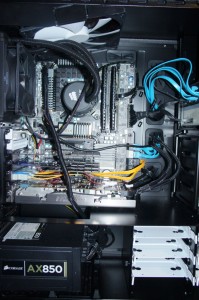This is The SSD Review Test Bench and a quick click on the photo will bring it up full size for closer inspection.
- Our main goal in testing is to ensure that all test results are as accurate as they can be and no anomalies slip through. We conduct all tests three times and, if necessary, we may conduct specific tests in Windows 7 ‘safe mode’ to ensure the OS has little to no influence on the end result.
- We prefer to use as many benchmark programs as possible to assist with confirmation of results and provide the reader with the actual tests as received to avoid any confusion when unexpected test benchmarks are received.
BENCH CONFIGURATION
MOTHERBOARD: Gigabyte P67A-UD7 ATX LGA 1155 Intel SATA 6Gb/s USB 3.0
CPU: Intel Core i7-2600K Sandy Bridge 3.4GHz (3.8GHz Turbo Boost) 4 x 256KB L2 Cache 8MB L3 Cache LGA 1155 95W Quad-Core Desktop Processor
RAM: Corsair Vengeance 12GB DDR3 1600 SDRAM
GPU: MSI N560GTX-Ti Twin Frozr II OC Edition 1024MB GDDR5 PCI Express 2.0
POWER: Corsair Professional Series AX850 850W ATX12V v2.31 / EPS12V v2.92 80 PLUS GOLD Certified Modular Active PFC Power Supply
CHASSIS: Fractal-Design Define XL ATX Mid Tower Silent Computer Case
CPU COOLER: Corsair H50 High Performance Water CPU Cooler
DVD: Sony Black 24X DVD+R 8X DVD+RW 8X DVD+R DL 24X DVD-R 6X DVD-RW 12X DVD-RAM 16X DVD-ROM 48X CD-R 32X CD-RW 48X CD-ROM 2MB Cache SATA 24X DVD Writer
BENCHMARK SOFTWARE
Software used for testing by The SSD Review consists of Crystal DiskMark, HDTune Pro, ATTO Benchmark, AS SSD, along with FutureMark PCMark Vantage.
The first four do a great job of showing us the numbers that we want to see, or dont want to see in some cases, while PCMark Vantage x64 is an excellent program which recreates tests that mimic the average users activity, all the while providing a medium to measure each.
SSD COMPRESSION AND TESTING FLUCTUATIONS
All SSDs are not created equal and many new SSD enthusiasts realize that when they test their new drive to confirm specifications and ensure all is in order. SandForce controlled SSDs, as in the AData S511 we are testing today, use compression techniques in storage whereas many others do not. This creates a bit of confusion when enthusiasts test the drive with random data through benchmarking programs such as AS SSD and Crystal Diskmark. The results seem to be lower than the listed specifications.
The results actually present a false portrayal of the drives ability when compared to other drives such as Samsung, Crucial or Intel. It is for this reason that all of our comparison testing is done through PCMark Vantage. PCMark Vantage HDD Suite simply provides evaluation results based on transfer speeds reached through typical user patterns. Vantage provides a better testing medium, in that, it sees through the typical synthetic benchmarks and provides us with ‘true to life’ results of the drive.
ATTO DISK BENCHMARK VER. 2.46
ATTO Disk Benchmark is perhaps one of the oldest benchmarks going and is definitely the main staple for manufacturer performance specifications. For our testing, we use a set length of 256mb and test both the read and write performance of various transfer sizes ranging from 0.5 to 8192kb. Manufacturers prefer this method of testing as it deals with raw data rather than random or mixed which, although more realistic, result with lower performance results.
 ATTO utilizes RAW data in its testing and is the most common methods for manufacturers to arrive at their listed specifications. The listed specs of 550MB/s read and 510MB/s write differed slightly from our result of 557MB/s read and 461MB/s write and this is understandable as test systems may differ in characteristics.
ATTO utilizes RAW data in its testing and is the most common methods for manufacturers to arrive at their listed specifications. The listed specs of 550MB/s read and 510MB/s write differed slightly from our result of 557MB/s read and 461MB/s write and this is understandable as test systems may differ in characteristics.
Pg 1 – Introduction and Physical Characteristics
Pg2 – Testing Protocol and Intial Tests
Pg3 – Crystal DiskMark and AS SSD Benchmarks
Pg4 – HDTunePro Testing
 The SSD Review The Worlds Dedicated SSD Education and Review Resource |
The SSD Review The Worlds Dedicated SSD Education and Review Resource | 
